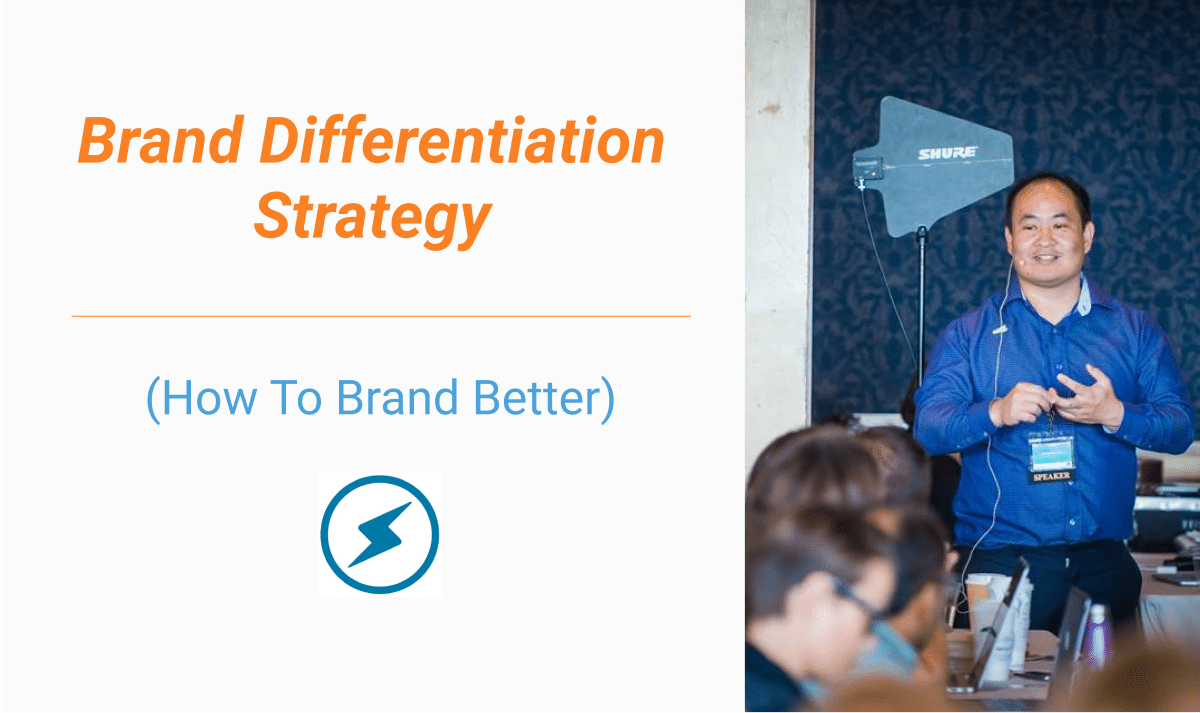
If you look at a map of the world and randomly put your finger on a place, often you can generate an image in your mind of the differences of that area compared to others. A similar thing happens with brands. Brands that develop a good brand differentiation strategy tend to stick out in our minds. We start to associate them with certain tastes, smells, products, and services.
We think of Ikea for naked furniture, for example, or Krispy Kreme for mouth-watering donuts. That’s because these companies have developed a good brand differentiation strategy, either intuitively or intentionally.
Sometimes though brands become so associated with their product, we conflate their name with it. For example, “Google it” means search for it online. “Hand me a Kleenex” means hand me a tissue, and “put on a Band-Aid” means bandage your wound.
These brand names have essentially become the product or service they offer. From a marketing standpoint, you might think this is a big win. But from a branding perspective, it could very well be a liability. When your brand becomes the product, it becomes a commodity, indistinct from all others.
For this reason, branding isn’t just one-and-done, and It’s important to have an ongoing brand differentiation strategy in place to ensure you keep maintaining your brand distinction advantages.
Problems with sameness and differentiation
Sameness is no good. When you look and act like every other brand, chances are you’re not going to win and keep the hearts of your customers.
According to Taddy Hall in this article for Time, even businesses that strive for brand differentiation can fall into the problem of sameness. Hall says the problem is brands that compete are not looking at consumers’ needs. From a feature standpoint, consumers don’t care about how your brand is different from other brands, as much as if the product you’re offering better solves their problem. The differentiation then, according to Hall, comes in having the better solution.
What helps brands in this struggle to differentiate, according to Hall? Innovation does. Innovation looks at the job-to-be-done of a product and figures out how you can make that better. For more on this job-to-be-done theory and how you can use that to increase product innovation, see this lecture from Harvard Business School professor Clay Christensen:
Product innovation and differentiation strategy
While innovating at the product level is ideal, the problem is that there are very few brands that can compete on innovation alone. In an interview, Peep Laja of Wynter points out a business can only go so long competing on product features. You have a couple of years of a head start before others start catching up with you. Peep thinks that a more likely candidate for brands to proclaim and sustain their differences is in their brand story.
Product features vs. brand messaging
Content Factory also sees engaging stories as central to building growth in an organization. In the video below, Content Factory founder, Dennis Yu, talks about how this engagement is the bridge between branding and sales.
He advises businesses to use a grid of stories that tell why a company exists, what they’re doing about that, and how they’ve positioned themselves to serve others to fulfill this goal. This strategy is called the 3×3 method, and it has proven effective in communicating corporate mission and vision into a bite-size messaging that customers relate to.
These brand stories work well on social media sites and other mediums where brands deliver their messaging. One of the places Content Factory has found success is in Facebook ads. For as little as a dollar a day, brands can publish and amplify Why, What, and How content on Facebook that engages their audience and shows the unique value in their brand stories.
Differentiation strategy in business
We can differentiate our business from our competitors in many different ways. According to the book Blue Ocean Strategy, the goal of a business should not be to compete but to flourish. The only thing that is holding us back is our unwillingness to modify our business model so that it doesn’t look like everyone else.
To do this, you must look beyond where most of your competitors are, and look to different models of doing business that you can then incorporate into your business structure.
Below are some strategies to consider when you want to give your brand a fresh perspective. Brands need to look at the following:
- Other industries: What are some business models typically used in other industries but not used in yours?
- Niche groups in your industry: What are some ways you can provide an inexpensive alternative to these niche groups (which usually charge more) but still give the customer a similar value?
- The chain of buyers: Who is involved in the transaction from producer to consumer? How can you reach people that your competitors don’t typically include in their marketing?
- Complementary product and service offerings: What is something that compliments your product or service that competitors don’t typically offer to their customers?
- A functional or emotional appeal to buyers: What kind of common customer problems need solving in your industry? How can you change the emotional appeal of your product or service and make it different from what is typically presented by your competition?
Emotional mapping your brand for difference
As branding is at least 50% emotion, one of the most important things we can do is have a differentiation strategy for emotional appeal.
A customer who feels connected to your brand is more apt to buy from you. That’s why building relationships is one of the most fundamental strategies a business can use to differentiate its brand. When brands can make strong human connections, they tend to flourish.
Decision-making is largely based on emotion. According to Kunle Campbell in this excellent article on marketing psychology in Big Commerce, “the richer the emotional content of a brand’s mental representation … the more likely a consumer will buy a product.
Eu Natural is a brand that has invested heavily in emotional branding. CEO Vinay Amin says, “Emotion drives the wheels of profitability. If your customers aren’t emotionally connected to your brand, then you’re not going to convert them as well, and you’re probably not going to retain them over the long term.”
Talia Wolf of Getuplift created an emotional targeting strategy to help brands get a handle on their emotional appeal. The method involves first assessing what emotion competitors in your industry appeal to and then from that, figuring out where to position your brand’s emotion. All of this can help us better understand what emotion our brand should relay to our customers and keep our brand distinct.
Here is Talia explaining the reasoning behind her method:
Personal branding in differentiation strategy
A complementary approach to emotional targeting is what Content Factory teaches, leading with a personal brand. When you lead with a personal brand, your business is as unique as you are. No one can take that away from you. Personal branding is a genuine appeal to relationships with customers and therefore is an ace-in-the-hole in brand building.
From a personal branding standpoint, Elon Musk is one great example. His reckless abandonment of the rules in the marketplace and his ability to shake things up keeps progress and innovation at the forefront of the customer’s brain. He also increases differentiation in his brand by being one of the few car company CEOs to be out in public making waves.
This is ingenious from a differentiation standpoint. It shows Musk as someone who is constantly finding ways to disrupt the system. He embodies the differentiation he tries to relay in his brand.
Tesla and Musk’s other brands are a model brand for disruption, progress, and innovation, just as Musk is himself. The more Musk positions himself in the limelight, the more his brands are also pushed into the limelight. Love him or hate him, Musk does personal branding well, and because of this, he can differentiate himself and his brands better.
The importance of customers in brand differentiation
Good off-page SEO is a result of PR. The best SEO is not the SEO you have to compete for, but the SEO that needs no competition because you have differentiated and amplified your brand. Publishers can’t help but bring you into the foreground, interview, and write about your brand.
Customers are the most important thing in brand identity. Listen to them. In today’s world of social media and user-generated content, brands are shaped by them more than ever.
Even more important is what customers tell each other. According to a survey by Stackla, 79% of consumers say user-generated content affects their purchasing decisions. Content Factory uses this content in a unique way called social amplification. When customers start creating content for you, you can amplify that content through social media to better promote your brand.
This user-generated content should also reflect the why, what, and how of the customer’s experience with your brand. People react well to hearing the stories of how others with similar problems had their lives changed by interacting with brands, and as the data above shows, these stories tend to drive and motivate purchases.
Brand differentiation strategy maintenance
As a company grows, its entrepreneurial spirit wanes. They become locked into methods and processes of doing things that may or may not be beneficial for maintaining their distinction amongst their competitors. That’s why competing on story vs. features is so important.
But sometimes, even these stories need to adapt to this growth.
One way to do this like a big company is to plan for and be open to adaptation. Make that a policy. Keep small, focused groups with big goals and entrepreneurial mindsets. Let them take risks.
Companies as big as 3M and Amazon also cross-pollinate their teams with innovators from other departments. This allows for disruption in group-think and a potential to break commonly held norms.
Changing the story, values, or norms of a company will also demand that leadership clearly defines the reason for updating the narrative. Leadership needs clarity and consistency to maintain this new direction.
Slowly implementing this change also helps. For example, eBay once decided to change its logo. After putting the new logo on their site, their customers complained. They hated it. They wanted the old logo back.
eBay returned their old logo to the site, but still determined to have the new one implemented. They devised a strategy to implement the new logo slowly, over time. They slowly changed colors and design elements, until finally after several of these small changes, they ended up with their new in place.
This time, no one even noticed, and if they did, they didn’t care. eBay had successfully conditioned their customers to accept the change through slow calculated iterations rather than massive disruption.
Relationships: one of the best ways to keep differentiating (and keep your customers)
The very best way to maintain your difference is to continue to maintain and build relationships with your customers.
As mentioned above, personal branding gives a brand character that can help us to do just that. Cementing these relationships with people not only helps you maintain brand differentiation it also helps you retain your customers.
People have basic needs. They want to feel valued and appreciated. Build deep relationships with your customers. Then they see you as a friend and not as someone that is just trying to extract value from them.
Keep telling stories, keep building value in people’s lives.
